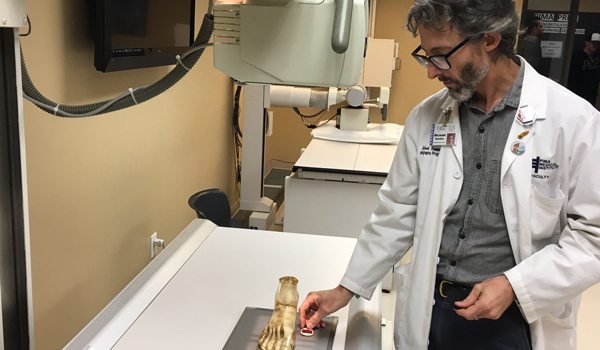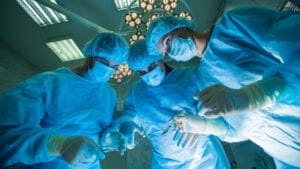 Radiography instructor Mike Hawkes is the first to admit he’s basically a big nerd. He loves science fiction and technology—two things that inspired him to go into the radiography field in the first place.
Radiography instructor Mike Hawkes is the first to admit he’s basically a big nerd. He loves science fiction and technology—two things that inspired him to go into the radiography field in the first place.
So it’s not surprising that he lets his inner nerd shine in the classroom, enriching students’ learning experiences through technology each day.
His methods and the students’ successes that have followed haven’t gone unnoticed. Recently the Accrediting Bureau of Health Education Schools (ABHES) and Elsevier, a provider of information solutions in the science, health and technology fields, awarded Hawkes with the 13th annual Master Teacher Award. He will be presented the award in Palm Springs, Calif., during ABHES’ annual conference on Feb. 24.
“Professor Hawkes is being recognized for his outstanding commitment to education, through his demonstration that leveraging technology and formative assessments increases a student’s self-efficacy, ultimately improving their overall learning,” said Lori Sypher, Vice President of Private Sector Sales with Elsevier. “The Master Teacher Award recognizes the work of an outstanding allied health faculty member who shows exceptional skill, innovation and effectiveness in regards to promoting student learning.”
It was technology that first attracted Hawkes to radiology. When he left a job at a hospital to teach at Pima Medical, he brought that love into the classroom.
“I love ‘Star Trek’ and science fiction in general, and when I learned there was an opportunity to work with cutting-edge technology and help people, it was too good to resist!” Hawkes said. “After graduating and working as a radiographer, I came to discover that I really liked mentoring students. Pima Medical called me one day at the hospital, asking if I’d ever considered teaching…sounded like an adventure!”
That sense of adventure is what drives him to create a unique learning environment for his students.
“One of (Hawkes) goals is to increase a student’s self-efficacy—a term which captures a student’s belief in their capacity to do what is required to meet a goal,” said Pima Medical Institute Mesa campus Faculty Coordinator, Nancy Daugherty. “Mike is also passionate about using technology to support his teaching. Specifically, Mike wanted to know whether providing more opportunities for formative assessment (leveraging technology) would increase a student’s self-efficacy that would ultimately result in improved learning outcomes.”
Hawkes set up a plan that allowed students to fill out an online form after each lesson, where they could rate their level of understanding. He would then see who needed further encouragement and create targeted, interactive videos that helped explain a lesson further.
“Using an online tool called ‘EDpuzzle,’ he was able to embed in the video stop points where students were required to answer a question before continuing,” Daugherty said. “This formative assessment allowed them to interact with the material, even though they were watching a video. Students could watch and re-watch an explanation on a topic they were having trouble grasping in class.”
Hawkes began to see result as semesters progressed based on students’ email responses. He was able to help students further while also using their feedback to create even better lessons. At the end of the semester, he provided students with a survey to evaluate the process. The responses he got were extremely positive.
“I have never done anything like that in school and it has been a huge help,” wrote a student who took the survey. “I know those took time and I just wanted to thank you for helping all of us out with preparing those for us so we will be more prepared for the final!”
Since becoming the Radiography Program Director at the Mesa campus in 2010, Hawkes has seen what students struggle with.
“The biggest hurdles students face are grasping the content and surviving clinical externships. Our approach for helping them excel with each of these challenges it to maintain an open-door policy and practice the GRAD approach to student success: Guide, Review, Adapt, Develop,” Hawkes said.
And as the radiography field evolves, so does Hawkes’ methods.
“The radiographer has become more separated from the radiologist. In the past, when film was still the medium for radiographic images, the radiographer would hand carry the films to the radiologist,” Hawkes explained. “Now that image process has become digital. The radiographer sends the images with a click to the radiologist that is rarely seen or spoken to. This change has required radiographers to be even more independent, competent and to possess even more critical thinking skills. To meet these demands, programs like ours have to continue to raise the bar—both in the selection process as well as the rigor of the program itself.”
Pima Medical Institute offers the radiography associate degree program at several campuses, including Mesa and Tucson, Ariz., Chula Vista, Calif., Denver, Las Vegas, Albuquerque, N.M., Houston and Seattle. To learn more about the program, visit https://pmi.edu/programs/associate/radiology.




